Families and Communities: Practitioner's Role, Theory, and Exclusion
VerifiedAdded on 2019/12/28
|7
|2523
|178
Report
AI Summary
This report delves into the multifaceted role of practitioners working with children, young people, and families within communities. It examines the responsibilities of practitioners in safeguarding interests, delivering government policies, and mitigating risks associated with social exclusion. The report applies relevant theories, such as attachment theory, to explain the societal perceptions and impacts of social exclusion, particularly on teenage parents and their families. It analyzes the negative consequences of social exclusion on children, young people, and families, including financial instability, mental health issues, and disruptions to social integration. The report concludes by emphasizing the importance of addressing social exclusion through education and community support to foster the well-being of all individuals.
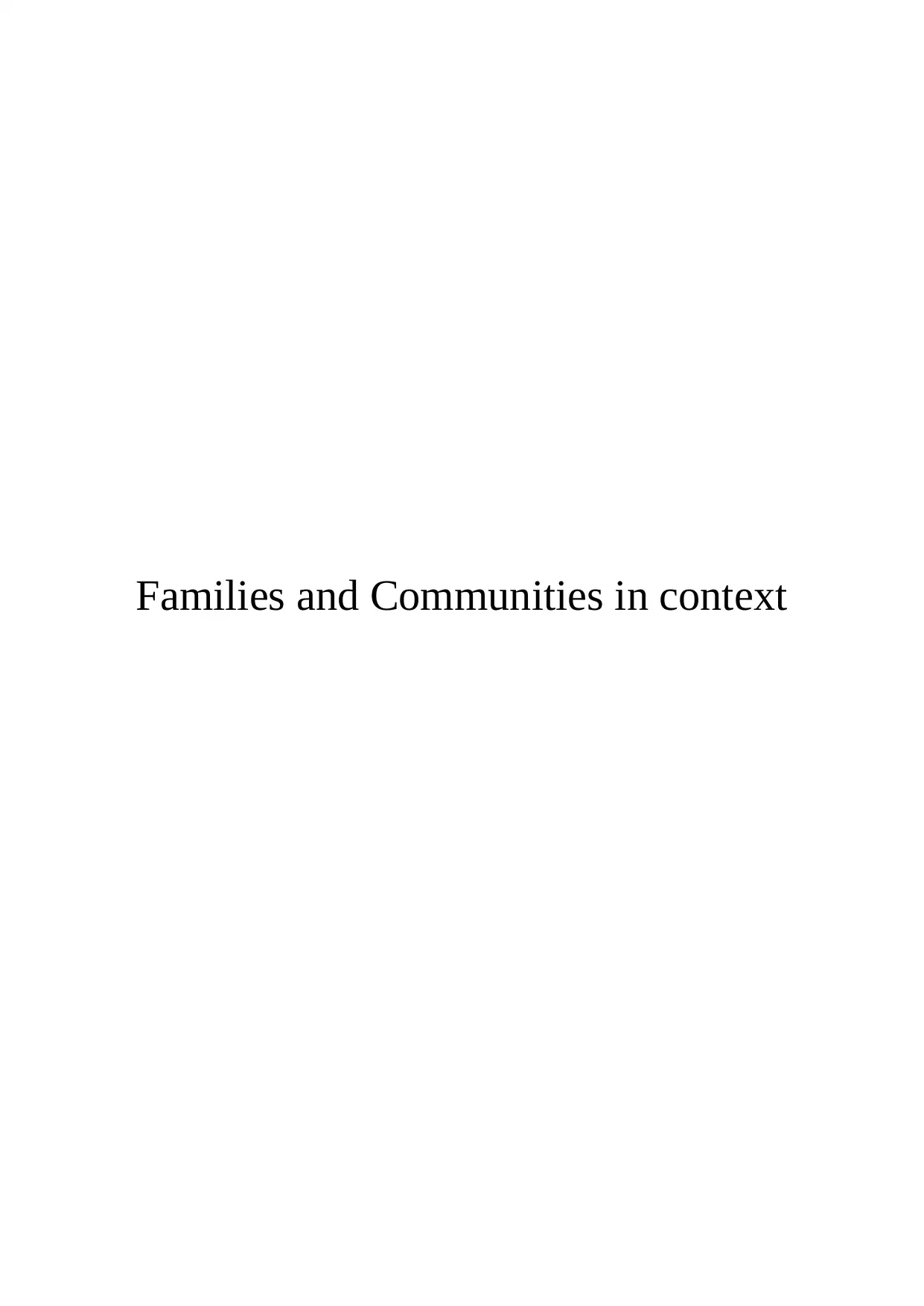
Families and Communities in context
Paraphrase This Document
Need a fresh take? Get an instant paraphrase of this document with our AI Paraphraser
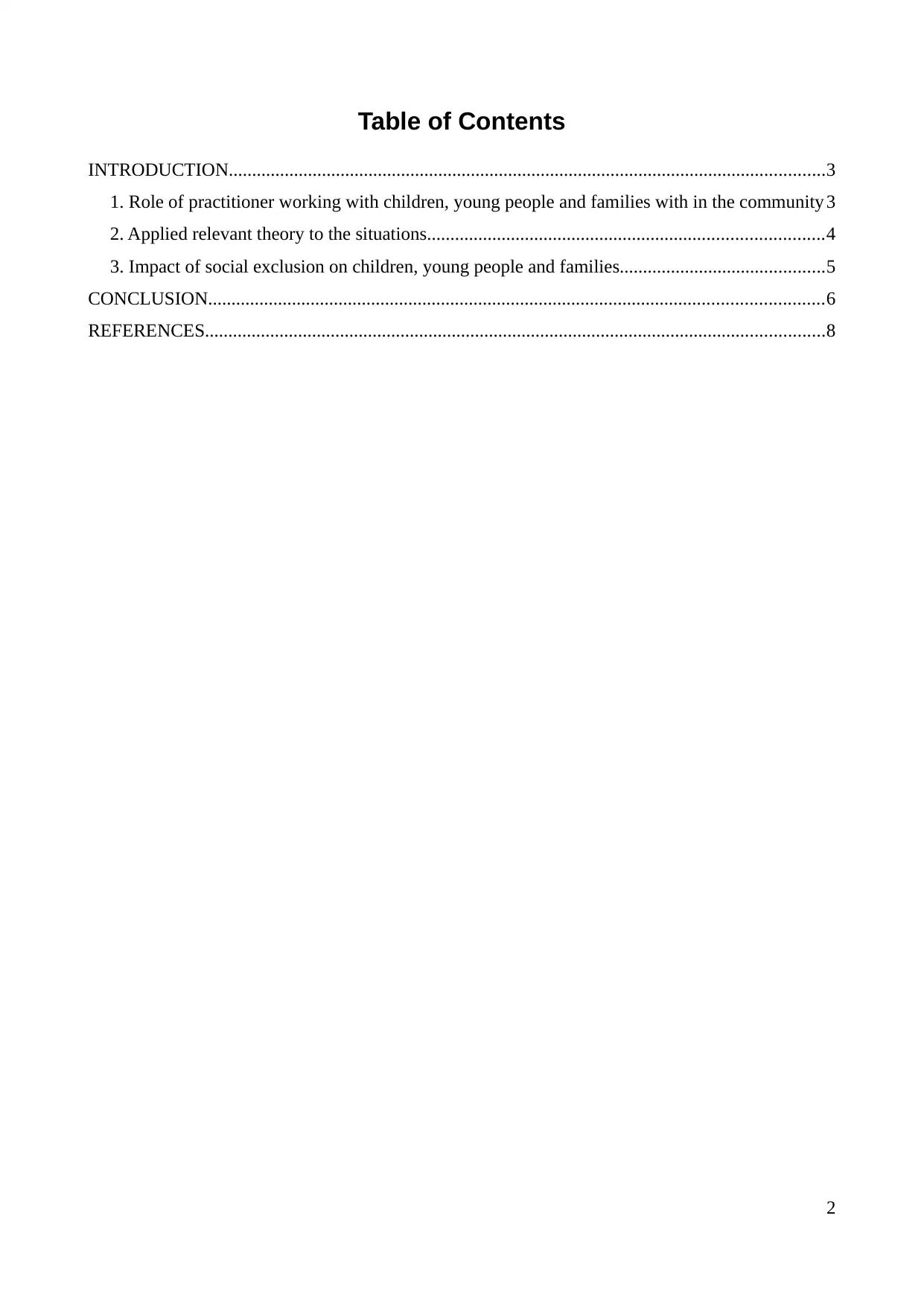
Table of Contents
INTRODUCTION................................................................................................................................3
1. Role of practitioner working with children, young people and families with in the community 3
2. Applied relevant theory to the situations.....................................................................................4
3. Impact of social exclusion on children, young people and families............................................5
CONCLUSION....................................................................................................................................6
REFERENCES.....................................................................................................................................8
2
INTRODUCTION................................................................................................................................3
1. Role of practitioner working with children, young people and families with in the community 3
2. Applied relevant theory to the situations.....................................................................................4
3. Impact of social exclusion on children, young people and families............................................5
CONCLUSION....................................................................................................................................6
REFERENCES.....................................................................................................................................8
2
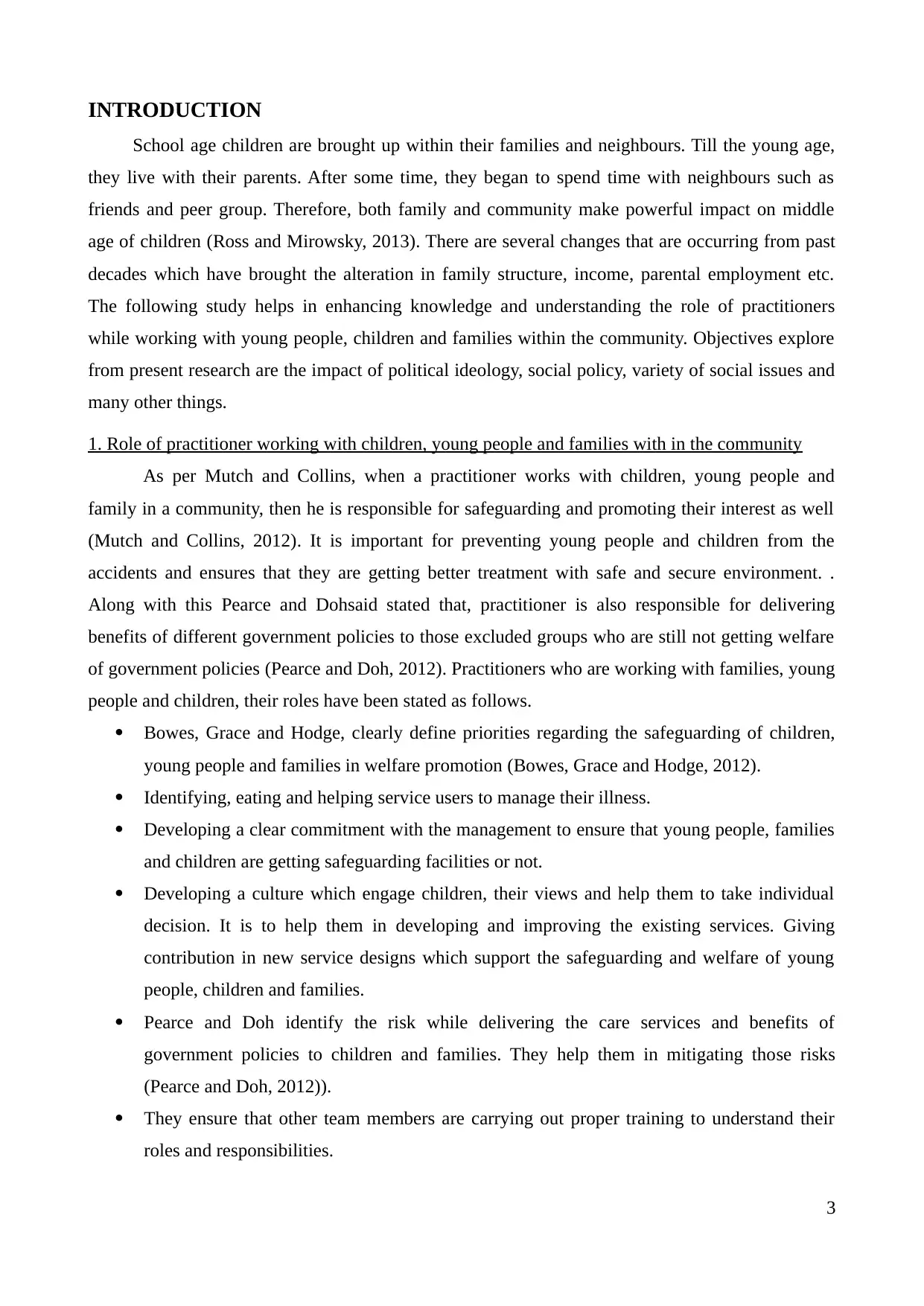
INTRODUCTION
School age children are brought up within their families and neighbours. Till the young age,
they live with their parents. After some time, they began to spend time with neighbours such as
friends and peer group. Therefore, both family and community make powerful impact on middle
age of children (Ross and Mirowsky, 2013). There are several changes that are occurring from past
decades which have brought the alteration in family structure, income, parental employment etc.
The following study helps in enhancing knowledge and understanding the role of practitioners
while working with young people, children and families within the community. Objectives explore
from present research are the impact of political ideology, social policy, variety of social issues and
many other things.
1. Role of practitioner working with children, young people and families with in the community
As per Mutch and Collins, when a practitioner works with children, young people and
family in a community, then he is responsible for safeguarding and promoting their interest as well
(Mutch and Collins, 2012). It is important for preventing young people and children from the
accidents and ensures that they are getting better treatment with safe and secure environment. .
Along with this Pearce and Dohsaid stated that, practitioner is also responsible for delivering
benefits of different government policies to those excluded groups who are still not getting welfare
of government policies (Pearce and Doh, 2012). Practitioners who are working with families, young
people and children, their roles have been stated as follows.
Bowes, Grace and Hodge, clearly define priorities regarding the safeguarding of children,
young people and families in welfare promotion (Bowes, Grace and Hodge, 2012).
Identifying, eating and helping service users to manage their illness.
Developing a clear commitment with the management to ensure that young people, families
and children are getting safeguarding facilities or not.
Developing a culture which engage children, their views and help them to take individual
decision. It is to help them in developing and improving the existing services. Giving
contribution in new service designs which support the safeguarding and welfare of young
people, children and families.
Pearce and Doh identify the risk while delivering the care services and benefits of
government policies to children and families. They help them in mitigating those risks
(Pearce and Doh, 2012)).
They ensure that other team members are carrying out proper training to understand their
roles and responsibilities.
3
School age children are brought up within their families and neighbours. Till the young age,
they live with their parents. After some time, they began to spend time with neighbours such as
friends and peer group. Therefore, both family and community make powerful impact on middle
age of children (Ross and Mirowsky, 2013). There are several changes that are occurring from past
decades which have brought the alteration in family structure, income, parental employment etc.
The following study helps in enhancing knowledge and understanding the role of practitioners
while working with young people, children and families within the community. Objectives explore
from present research are the impact of political ideology, social policy, variety of social issues and
many other things.
1. Role of practitioner working with children, young people and families with in the community
As per Mutch and Collins, when a practitioner works with children, young people and
family in a community, then he is responsible for safeguarding and promoting their interest as well
(Mutch and Collins, 2012). It is important for preventing young people and children from the
accidents and ensures that they are getting better treatment with safe and secure environment. .
Along with this Pearce and Dohsaid stated that, practitioner is also responsible for delivering
benefits of different government policies to those excluded groups who are still not getting welfare
of government policies (Pearce and Doh, 2012). Practitioners who are working with families, young
people and children, their roles have been stated as follows.
Bowes, Grace and Hodge, clearly define priorities regarding the safeguarding of children,
young people and families in welfare promotion (Bowes, Grace and Hodge, 2012).
Identifying, eating and helping service users to manage their illness.
Developing a clear commitment with the management to ensure that young people, families
and children are getting safeguarding facilities or not.
Developing a culture which engage children, their views and help them to take individual
decision. It is to help them in developing and improving the existing services. Giving
contribution in new service designs which support the safeguarding and welfare of young
people, children and families.
Pearce and Doh identify the risk while delivering the care services and benefits of
government policies to children and families. They help them in mitigating those risks
(Pearce and Doh, 2012)).
They ensure that other team members are carrying out proper training to understand their
roles and responsibilities.
3
⊘ This is a preview!⊘
Do you want full access?
Subscribe today to unlock all pages.

Trusted by 1+ million students worldwide
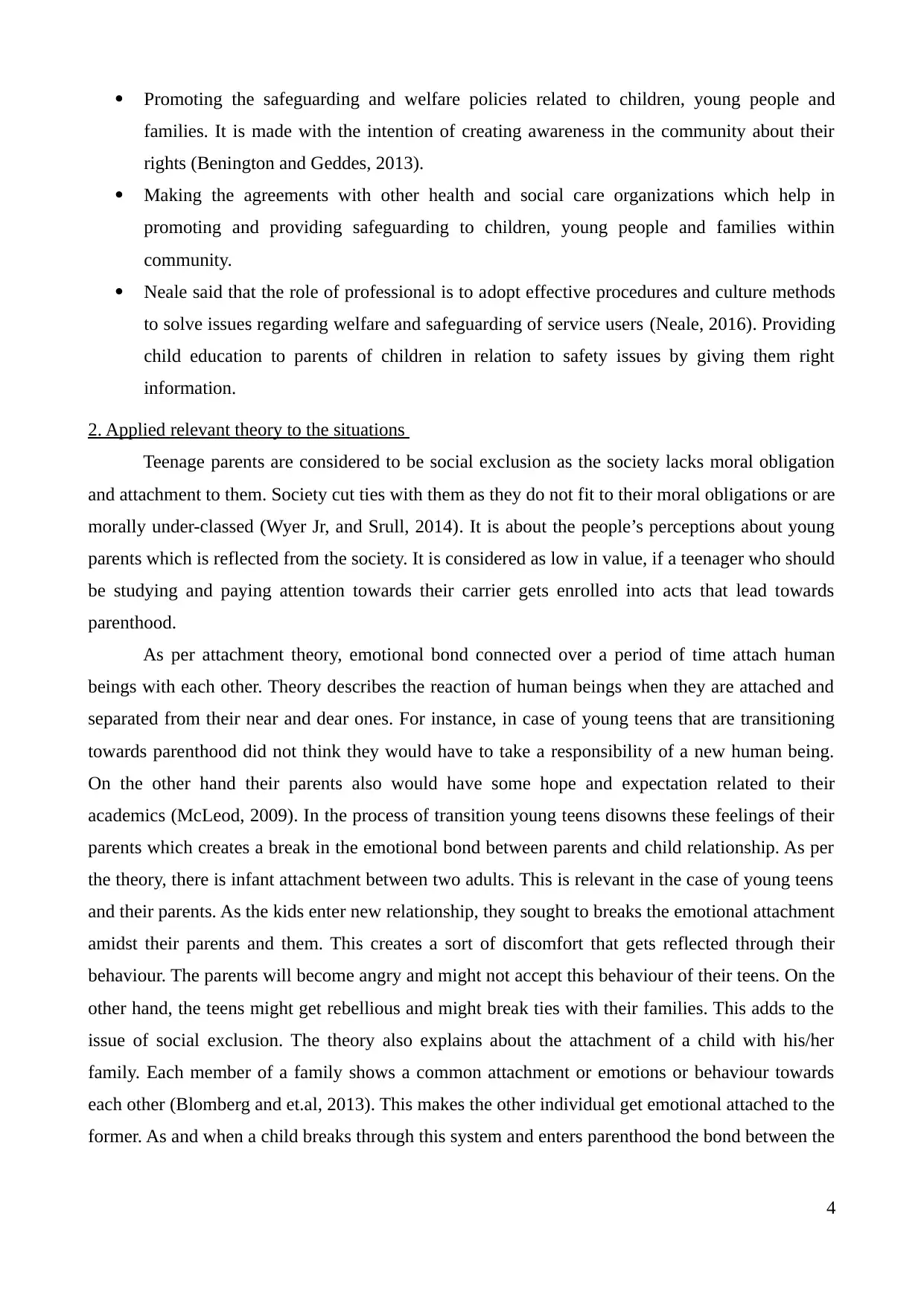
Promoting the safeguarding and welfare policies related to children, young people and
families. It is made with the intention of creating awareness in the community about their
rights (Benington and Geddes, 2013).
Making the agreements with other health and social care organizations which help in
promoting and providing safeguarding to children, young people and families within
community.
Neale said that the role of professional is to adopt effective procedures and culture methods
to solve issues regarding welfare and safeguarding of service users (Neale, 2016). Providing
child education to parents of children in relation to safety issues by giving them right
information.
2. Applied relevant theory to the situations
Teenage parents are considered to be social exclusion as the society lacks moral obligation
and attachment to them. Society cut ties with them as they do not fit to their moral obligations or are
morally under-classed (Wyer Jr, and Srull, 2014). It is about the people’s perceptions about young
parents which is reflected from the society. It is considered as low in value, if a teenager who should
be studying and paying attention towards their carrier gets enrolled into acts that lead towards
parenthood.
As per attachment theory, emotional bond connected over a period of time attach human
beings with each other. Theory describes the reaction of human beings when they are attached and
separated from their near and dear ones. For instance, in case of young teens that are transitioning
towards parenthood did not think they would have to take a responsibility of a new human being.
On the other hand their parents also would have some hope and expectation related to their
academics (McLeod, 2009). In the process of transition young teens disowns these feelings of their
parents which creates a break in the emotional bond between parents and child relationship. As per
the theory, there is infant attachment between two adults. This is relevant in the case of young teens
and their parents. As the kids enter new relationship, they sought to breaks the emotional attachment
amidst their parents and them. This creates a sort of discomfort that gets reflected through their
behaviour. The parents will become angry and might not accept this behaviour of their teens. On the
other hand, the teens might get rebellious and might break ties with their families. This adds to the
issue of social exclusion. The theory also explains about the attachment of a child with his/her
family. Each member of a family shows a common attachment or emotions or behaviour towards
each other (Blomberg and et.al, 2013). This makes the other individual get emotional attached to the
former. As and when a child breaks through this system and enters parenthood the bond between the
4
families. It is made with the intention of creating awareness in the community about their
rights (Benington and Geddes, 2013).
Making the agreements with other health and social care organizations which help in
promoting and providing safeguarding to children, young people and families within
community.
Neale said that the role of professional is to adopt effective procedures and culture methods
to solve issues regarding welfare and safeguarding of service users (Neale, 2016). Providing
child education to parents of children in relation to safety issues by giving them right
information.
2. Applied relevant theory to the situations
Teenage parents are considered to be social exclusion as the society lacks moral obligation
and attachment to them. Society cut ties with them as they do not fit to their moral obligations or are
morally under-classed (Wyer Jr, and Srull, 2014). It is about the people’s perceptions about young
parents which is reflected from the society. It is considered as low in value, if a teenager who should
be studying and paying attention towards their carrier gets enrolled into acts that lead towards
parenthood.
As per attachment theory, emotional bond connected over a period of time attach human
beings with each other. Theory describes the reaction of human beings when they are attached and
separated from their near and dear ones. For instance, in case of young teens that are transitioning
towards parenthood did not think they would have to take a responsibility of a new human being.
On the other hand their parents also would have some hope and expectation related to their
academics (McLeod, 2009). In the process of transition young teens disowns these feelings of their
parents which creates a break in the emotional bond between parents and child relationship. As per
the theory, there is infant attachment between two adults. This is relevant in the case of young teens
and their parents. As the kids enter new relationship, they sought to breaks the emotional attachment
amidst their parents and them. This creates a sort of discomfort that gets reflected through their
behaviour. The parents will become angry and might not accept this behaviour of their teens. On the
other hand, the teens might get rebellious and might break ties with their families. This adds to the
issue of social exclusion. The theory also explains about the attachment of a child with his/her
family. Each member of a family shows a common attachment or emotions or behaviour towards
each other (Blomberg and et.al, 2013). This makes the other individual get emotional attached to the
former. As and when a child breaks through this system and enters parenthood the bond between the
4
Paraphrase This Document
Need a fresh take? Get an instant paraphrase of this document with our AI Paraphraser
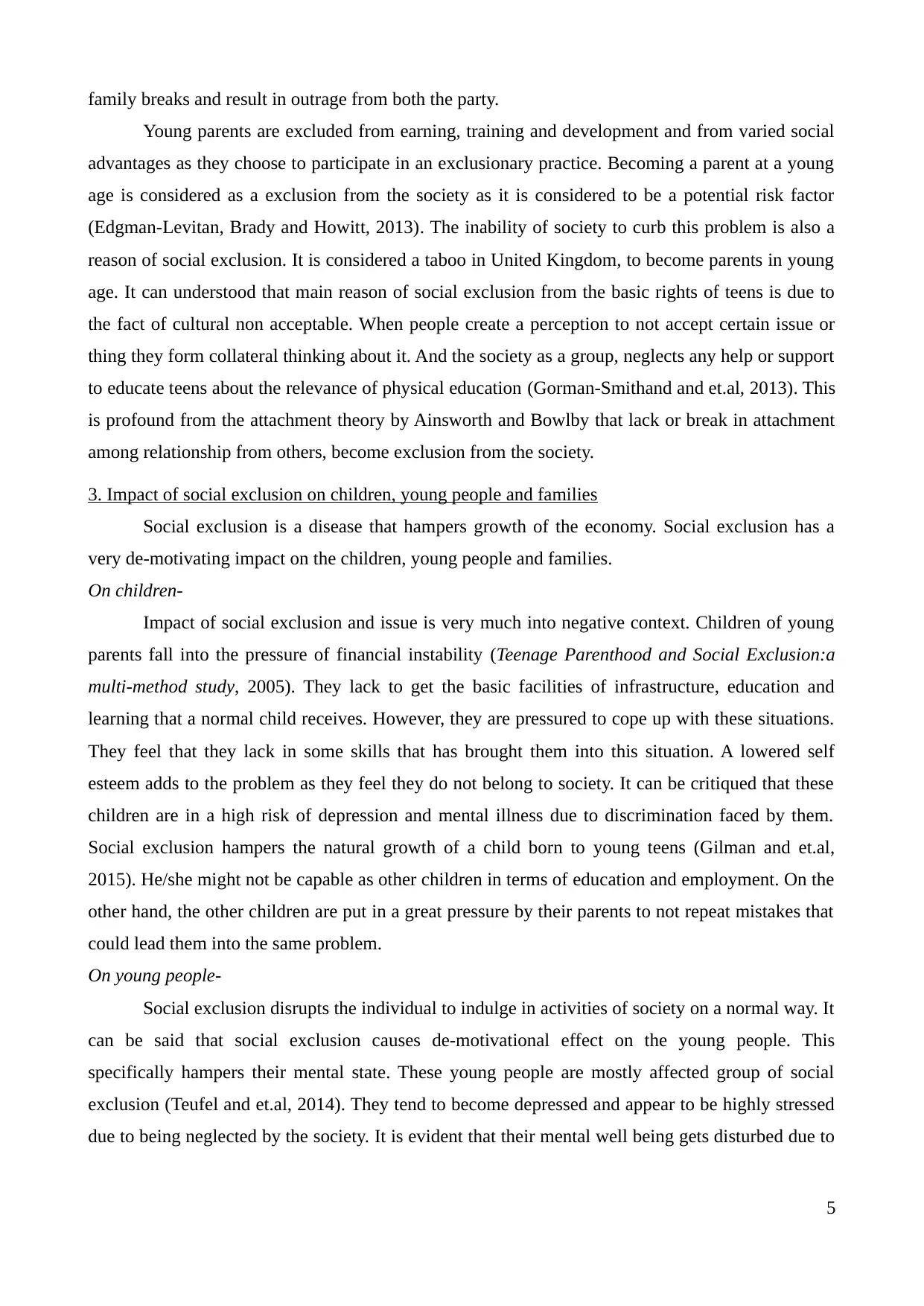
family breaks and result in outrage from both the party.
Young parents are excluded from earning, training and development and from varied social
advantages as they choose to participate in an exclusionary practice. Becoming a parent at a young
age is considered as a exclusion from the society as it is considered to be a potential risk factor
(Edgman-Levitan, Brady and Howitt, 2013). The inability of society to curb this problem is also a
reason of social exclusion. It is considered a taboo in United Kingdom, to become parents in young
age. It can understood that main reason of social exclusion from the basic rights of teens is due to
the fact of cultural non acceptable. When people create a perception to not accept certain issue or
thing they form collateral thinking about it. And the society as a group, neglects any help or support
to educate teens about the relevance of physical education (Gorman-Smithand and et.al, 2013). This
is profound from the attachment theory by Ainsworth and Bowlby that lack or break in attachment
among relationship from others, become exclusion from the society.
3. Impact of social exclusion on children, young people and families
Social exclusion is a disease that hampers growth of the economy. Social exclusion has a
very de-motivating impact on the children, young people and families.
On children-
Impact of social exclusion and issue is very much into negative context. Children of young
parents fall into the pressure of financial instability (Teenage Parenthood and Social Exclusion:a
multi-method study, 2005). They lack to get the basic facilities of infrastructure, education and
learning that a normal child receives. However, they are pressured to cope up with these situations.
They feel that they lack in some skills that has brought them into this situation. A lowered self
esteem adds to the problem as they feel they do not belong to society. It can be critiqued that these
children are in a high risk of depression and mental illness due to discrimination faced by them.
Social exclusion hampers the natural growth of a child born to young teens (Gilman and et.al,
2015). He/she might not be capable as other children in terms of education and employment. On the
other hand, the other children are put in a great pressure by their parents to not repeat mistakes that
could lead them into the same problem.
On young people-
Social exclusion disrupts the individual to indulge in activities of society on a normal way. It
can be said that social exclusion causes de-motivational effect on the young people. This
specifically hampers their mental state. These young people are mostly affected group of social
exclusion (Teufel and et.al, 2014). They tend to become depressed and appear to be highly stressed
due to being neglected by the society. It is evident that their mental well being gets disturbed due to
5
Young parents are excluded from earning, training and development and from varied social
advantages as they choose to participate in an exclusionary practice. Becoming a parent at a young
age is considered as a exclusion from the society as it is considered to be a potential risk factor
(Edgman-Levitan, Brady and Howitt, 2013). The inability of society to curb this problem is also a
reason of social exclusion. It is considered a taboo in United Kingdom, to become parents in young
age. It can understood that main reason of social exclusion from the basic rights of teens is due to
the fact of cultural non acceptable. When people create a perception to not accept certain issue or
thing they form collateral thinking about it. And the society as a group, neglects any help or support
to educate teens about the relevance of physical education (Gorman-Smithand and et.al, 2013). This
is profound from the attachment theory by Ainsworth and Bowlby that lack or break in attachment
among relationship from others, become exclusion from the society.
3. Impact of social exclusion on children, young people and families
Social exclusion is a disease that hampers growth of the economy. Social exclusion has a
very de-motivating impact on the children, young people and families.
On children-
Impact of social exclusion and issue is very much into negative context. Children of young
parents fall into the pressure of financial instability (Teenage Parenthood and Social Exclusion:a
multi-method study, 2005). They lack to get the basic facilities of infrastructure, education and
learning that a normal child receives. However, they are pressured to cope up with these situations.
They feel that they lack in some skills that has brought them into this situation. A lowered self
esteem adds to the problem as they feel they do not belong to society. It can be critiqued that these
children are in a high risk of depression and mental illness due to discrimination faced by them.
Social exclusion hampers the natural growth of a child born to young teens (Gilman and et.al,
2015). He/she might not be capable as other children in terms of education and employment. On the
other hand, the other children are put in a great pressure by their parents to not repeat mistakes that
could lead them into the same problem.
On young people-
Social exclusion disrupts the individual to indulge in activities of society on a normal way. It
can be said that social exclusion causes de-motivational effect on the young people. This
specifically hampers their mental state. These young people are mostly affected group of social
exclusion (Teufel and et.al, 2014). They tend to become depressed and appear to be highly stressed
due to being neglected by the society. It is evident that their mental well being gets disturbed due to
5
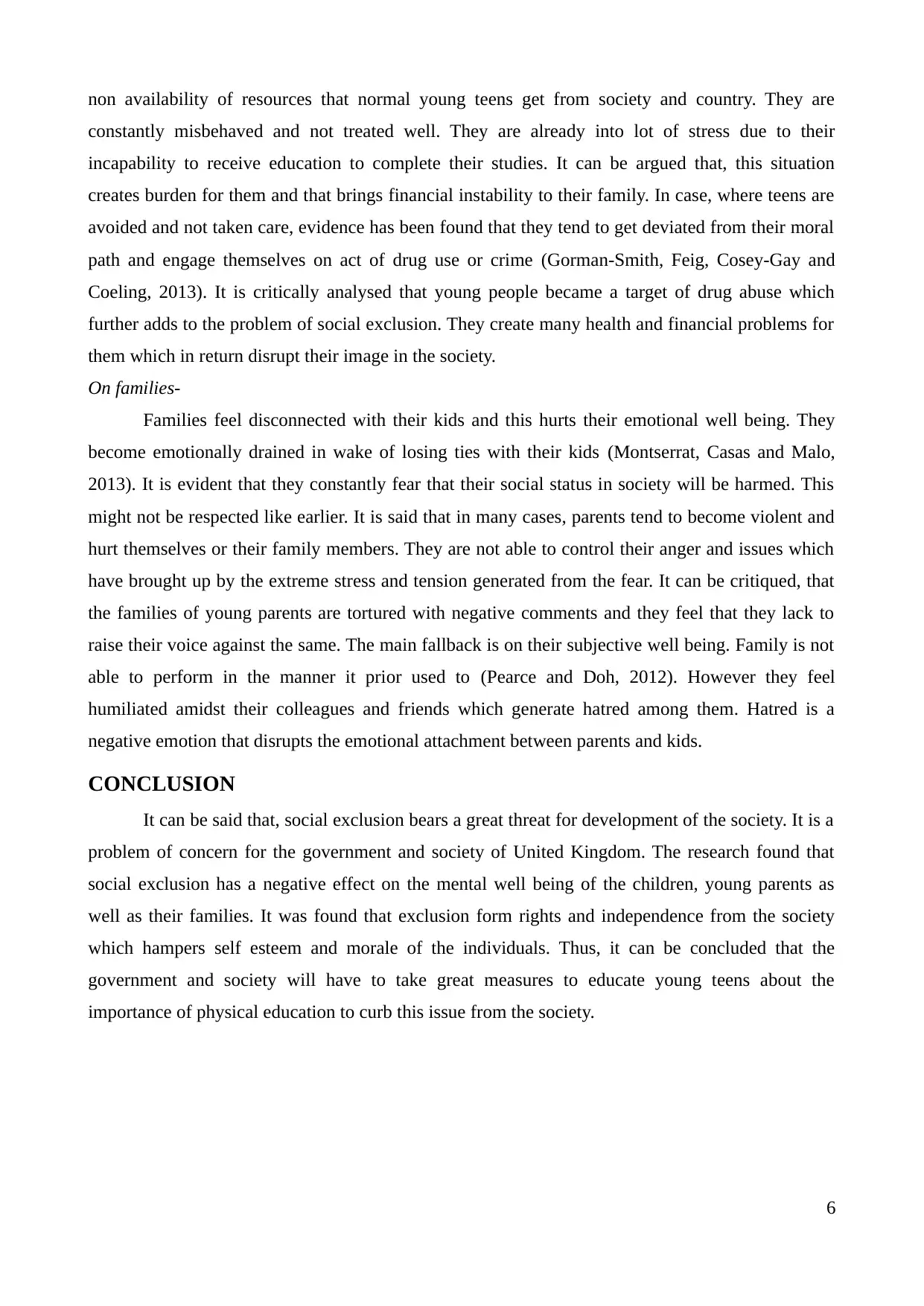
non availability of resources that normal young teens get from society and country. They are
constantly misbehaved and not treated well. They are already into lot of stress due to their
incapability to receive education to complete their studies. It can be argued that, this situation
creates burden for them and that brings financial instability to their family. In case, where teens are
avoided and not taken care, evidence has been found that they tend to get deviated from their moral
path and engage themselves on act of drug use or crime (Gorman-Smith, Feig, Cosey-Gay and
Coeling, 2013). It is critically analysed that young people became a target of drug abuse which
further adds to the problem of social exclusion. They create many health and financial problems for
them which in return disrupt their image in the society.
On families-
Families feel disconnected with their kids and this hurts their emotional well being. They
become emotionally drained in wake of losing ties with their kids (Montserrat, Casas and Malo,
2013). It is evident that they constantly fear that their social status in society will be harmed. This
might not be respected like earlier. It is said that in many cases, parents tend to become violent and
hurt themselves or their family members. They are not able to control their anger and issues which
have brought up by the extreme stress and tension generated from the fear. It can be critiqued, that
the families of young parents are tortured with negative comments and they feel that they lack to
raise their voice against the same. The main fallback is on their subjective well being. Family is not
able to perform in the manner it prior used to (Pearce and Doh, 2012). However they feel
humiliated amidst their colleagues and friends which generate hatred among them. Hatred is a
negative emotion that disrupts the emotional attachment between parents and kids.
CONCLUSION
It can be said that, social exclusion bears a great threat for development of the society. It is a
problem of concern for the government and society of United Kingdom. The research found that
social exclusion has a negative effect on the mental well being of the children, young parents as
well as their families. It was found that exclusion form rights and independence from the society
which hampers self esteem and morale of the individuals. Thus, it can be concluded that the
government and society will have to take great measures to educate young teens about the
importance of physical education to curb this issue from the society.
6
constantly misbehaved and not treated well. They are already into lot of stress due to their
incapability to receive education to complete their studies. It can be argued that, this situation
creates burden for them and that brings financial instability to their family. In case, where teens are
avoided and not taken care, evidence has been found that they tend to get deviated from their moral
path and engage themselves on act of drug use or crime (Gorman-Smith, Feig, Cosey-Gay and
Coeling, 2013). It is critically analysed that young people became a target of drug abuse which
further adds to the problem of social exclusion. They create many health and financial problems for
them which in return disrupt their image in the society.
On families-
Families feel disconnected with their kids and this hurts their emotional well being. They
become emotionally drained in wake of losing ties with their kids (Montserrat, Casas and Malo,
2013). It is evident that they constantly fear that their social status in society will be harmed. This
might not be respected like earlier. It is said that in many cases, parents tend to become violent and
hurt themselves or their family members. They are not able to control their anger and issues which
have brought up by the extreme stress and tension generated from the fear. It can be critiqued, that
the families of young parents are tortured with negative comments and they feel that they lack to
raise their voice against the same. The main fallback is on their subjective well being. Family is not
able to perform in the manner it prior used to (Pearce and Doh, 2012). However they feel
humiliated amidst their colleagues and friends which generate hatred among them. Hatred is a
negative emotion that disrupts the emotional attachment between parents and kids.
CONCLUSION
It can be said that, social exclusion bears a great threat for development of the society. It is a
problem of concern for the government and society of United Kingdom. The research found that
social exclusion has a negative effect on the mental well being of the children, young parents as
well as their families. It was found that exclusion form rights and independence from the society
which hampers self esteem and morale of the individuals. Thus, it can be concluded that the
government and society will have to take great measures to educate young teens about the
importance of physical education to curb this issue from the society.
6
⊘ This is a preview!⊘
Do you want full access?
Subscribe today to unlock all pages.

Trusted by 1+ million students worldwide
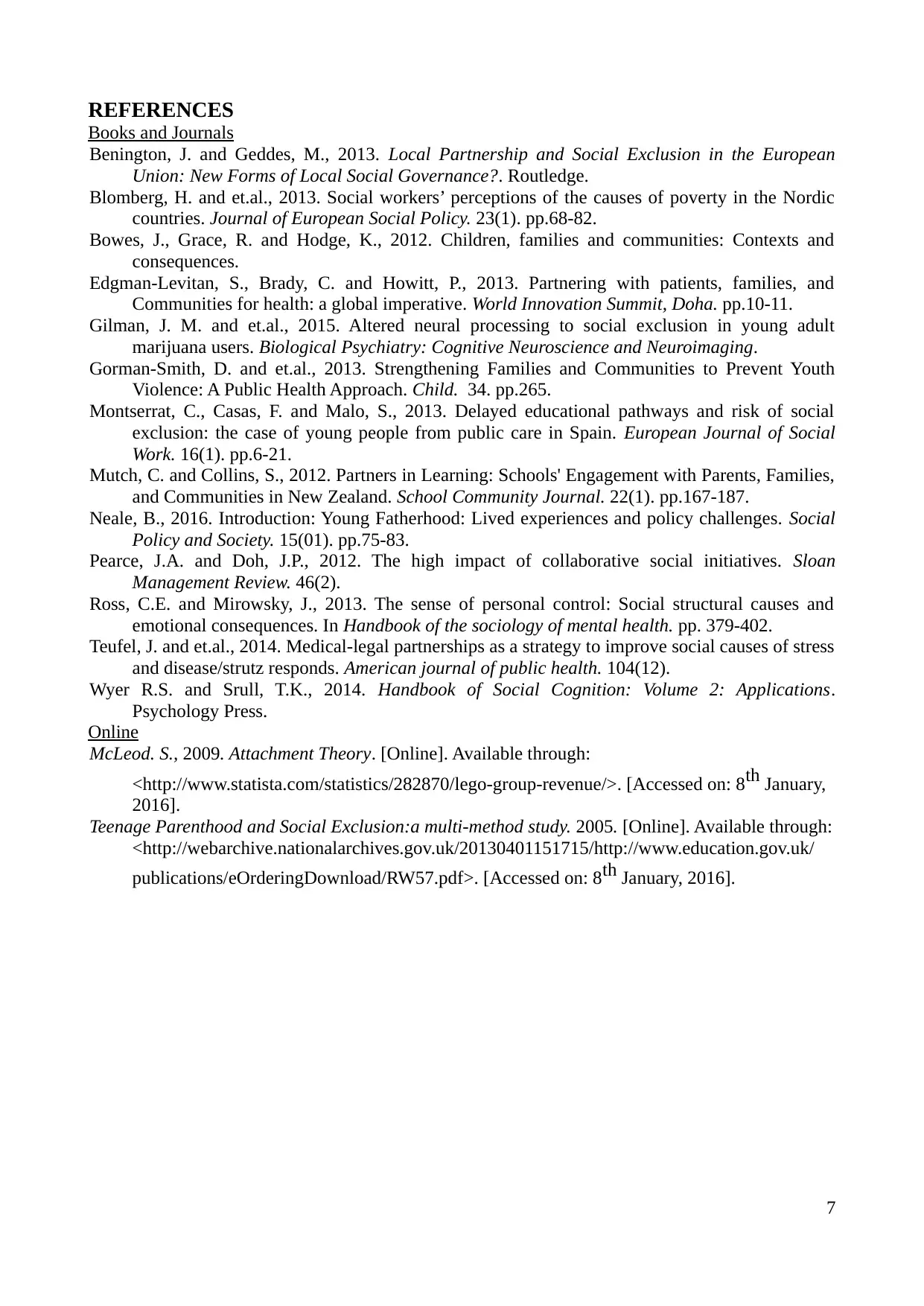
REFERENCES
Books and Journals
Benington, J. and Geddes, M., 2013. Local Partnership and Social Exclusion in the European
Union: New Forms of Local Social Governance?. Routledge.
Blomberg, H. and et.al., 2013. Social workers’ perceptions of the causes of poverty in the Nordic
countries. Journal of European Social Policy. 23(1). pp.68-82.
Bowes, J., Grace, R. and Hodge, K., 2012. Children, families and communities: Contexts and
consequences.
Edgman-Levitan, S., Brady, C. and Howitt, P., 2013. Partnering with patients, families, and
Communities for health: a global imperative. World Innovation Summit, Doha. pp.10-11.
Gilman, J. M. and et.al., 2015. Altered neural processing to social exclusion in young adult
marijuana users. Biological Psychiatry: Cognitive Neuroscience and Neuroimaging.
Gorman-Smith, D. and et.al., 2013. Strengthening Families and Communities to Prevent Youth
Violence: A Public Health Approach. Child. 34. pp.265.
Montserrat, C., Casas, F. and Malo, S., 2013. Delayed educational pathways and risk of social
exclusion: the case of young people from public care in Spain. European Journal of Social
Work. 16(1). pp.6-21.
Mutch, C. and Collins, S., 2012. Partners in Learning: Schools' Engagement with Parents, Families,
and Communities in New Zealand. School Community Journal. 22(1). pp.167-187.
Neale, B., 2016. Introduction: Young Fatherhood: Lived experiences and policy challenges. Social
Policy and Society. 15(01). pp.75-83.
Pearce, J.A. and Doh, J.P., 2012. The high impact of collaborative social initiatives. Sloan
Management Review. 46(2).
Ross, C.E. and Mirowsky, J., 2013. The sense of personal control: Social structural causes and
emotional consequences. In Handbook of the sociology of mental health. pp. 379-402.
Teufel, J. and et.al., 2014. Medical-legal partnerships as a strategy to improve social causes of stress
and disease/strutz responds. American journal of public health. 104(12).
Wyer R.S. and Srull, T.K., 2014. Handbook of Social Cognition: Volume 2: Applications.
Psychology Press.
Online
McLeod. S., 2009. Attachment Theory. [Online]. Available through:
<http://www.statista.com/statistics/282870/lego-group-revenue/>. [Accessed on: 8th January,
2016].
Teenage Parenthood and Social Exclusion:a multi-method study. 2005. [Online]. Available through:
<http://webarchive.nationalarchives.gov.uk/20130401151715/http://www.education.gov.uk/
publications/eOrderingDownload/RW57.pdf>. [Accessed on: 8th January, 2016].
7
Books and Journals
Benington, J. and Geddes, M., 2013. Local Partnership and Social Exclusion in the European
Union: New Forms of Local Social Governance?. Routledge.
Blomberg, H. and et.al., 2013. Social workers’ perceptions of the causes of poverty in the Nordic
countries. Journal of European Social Policy. 23(1). pp.68-82.
Bowes, J., Grace, R. and Hodge, K., 2012. Children, families and communities: Contexts and
consequences.
Edgman-Levitan, S., Brady, C. and Howitt, P., 2013. Partnering with patients, families, and
Communities for health: a global imperative. World Innovation Summit, Doha. pp.10-11.
Gilman, J. M. and et.al., 2015. Altered neural processing to social exclusion in young adult
marijuana users. Biological Psychiatry: Cognitive Neuroscience and Neuroimaging.
Gorman-Smith, D. and et.al., 2013. Strengthening Families and Communities to Prevent Youth
Violence: A Public Health Approach. Child. 34. pp.265.
Montserrat, C., Casas, F. and Malo, S., 2013. Delayed educational pathways and risk of social
exclusion: the case of young people from public care in Spain. European Journal of Social
Work. 16(1). pp.6-21.
Mutch, C. and Collins, S., 2012. Partners in Learning: Schools' Engagement with Parents, Families,
and Communities in New Zealand. School Community Journal. 22(1). pp.167-187.
Neale, B., 2016. Introduction: Young Fatherhood: Lived experiences and policy challenges. Social
Policy and Society. 15(01). pp.75-83.
Pearce, J.A. and Doh, J.P., 2012. The high impact of collaborative social initiatives. Sloan
Management Review. 46(2).
Ross, C.E. and Mirowsky, J., 2013. The sense of personal control: Social structural causes and
emotional consequences. In Handbook of the sociology of mental health. pp. 379-402.
Teufel, J. and et.al., 2014. Medical-legal partnerships as a strategy to improve social causes of stress
and disease/strutz responds. American journal of public health. 104(12).
Wyer R.S. and Srull, T.K., 2014. Handbook of Social Cognition: Volume 2: Applications.
Psychology Press.
Online
McLeod. S., 2009. Attachment Theory. [Online]. Available through:
<http://www.statista.com/statistics/282870/lego-group-revenue/>. [Accessed on: 8th January,
2016].
Teenage Parenthood and Social Exclusion:a multi-method study. 2005. [Online]. Available through:
<http://webarchive.nationalarchives.gov.uk/20130401151715/http://www.education.gov.uk/
publications/eOrderingDownload/RW57.pdf>. [Accessed on: 8th January, 2016].
7
1 out of 7
Related Documents
Your All-in-One AI-Powered Toolkit for Academic Success.
+13062052269
info@desklib.com
Available 24*7 on WhatsApp / Email
![[object Object]](/_next/static/media/star-bottom.7253800d.svg)
Unlock your academic potential
Copyright © 2020–2025 A2Z Services. All Rights Reserved. Developed and managed by ZUCOL.





